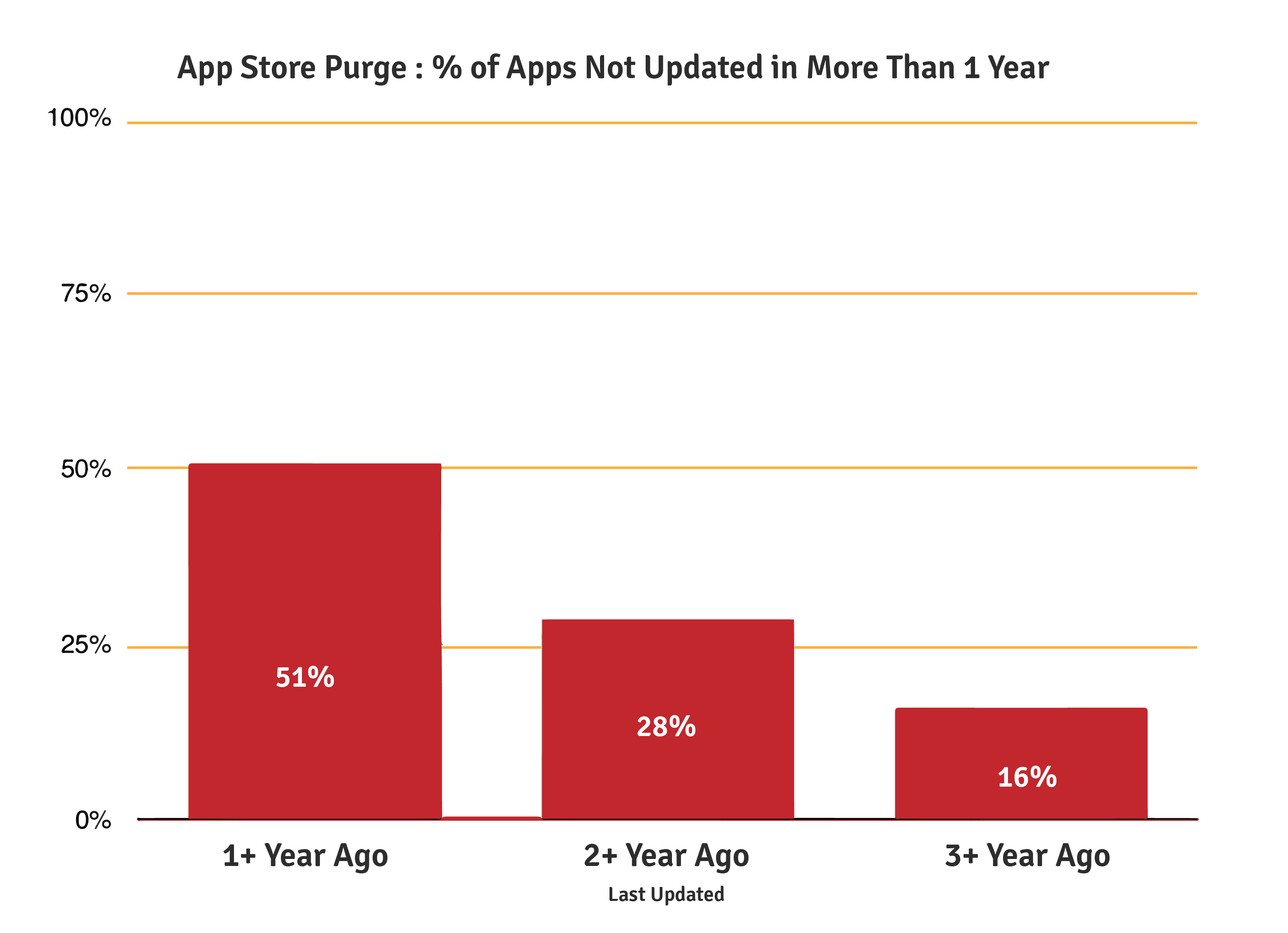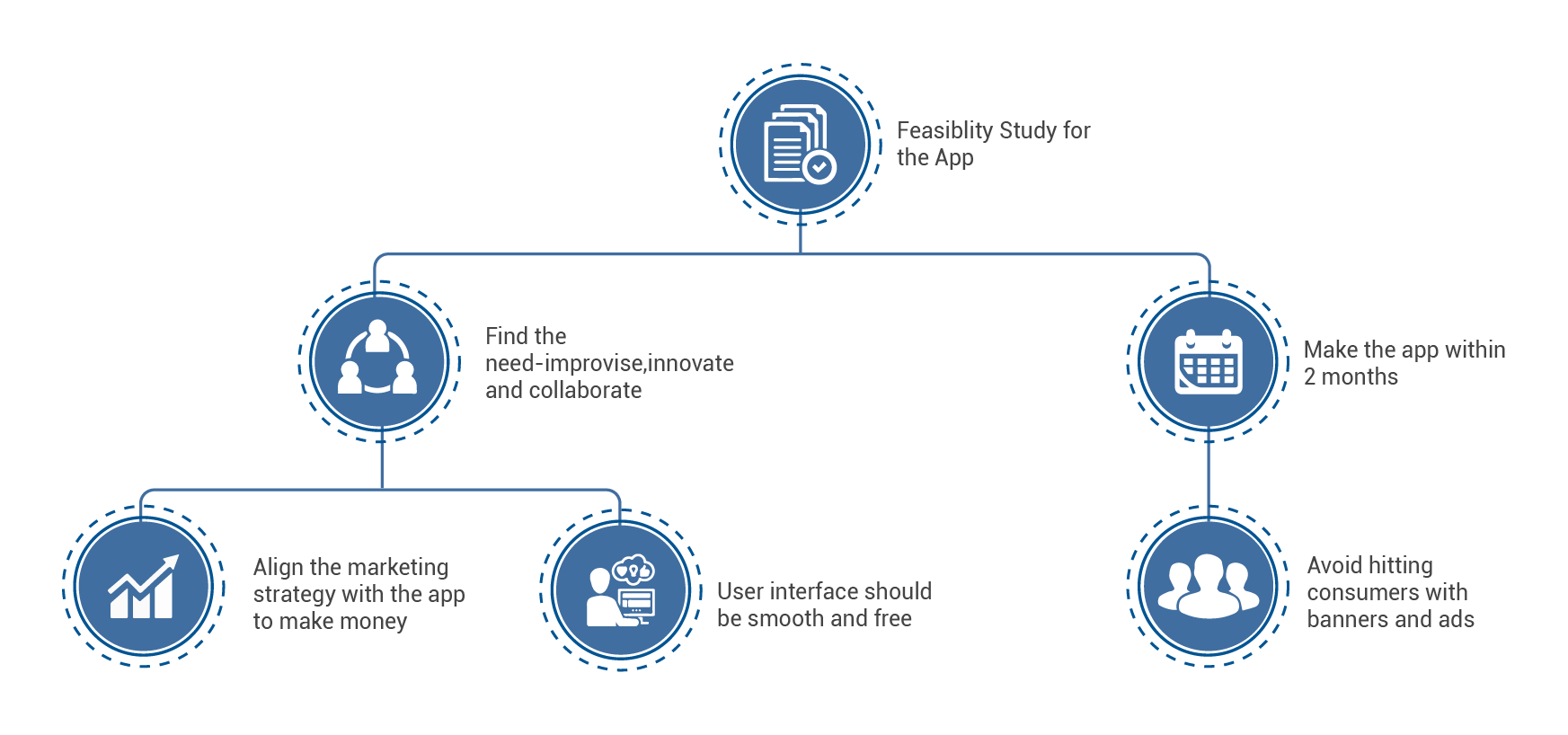Tag: business mobile app development
You are planning to build an app for your business. You zero in on the app features, then develop it and finally release your app to the respective stores. You actively monitor your app’s usage and analytics. Your users are happy and they actively use your app. After a while, you notice a dip in the curve.
Your app starts falling behind in-store listings, garners poor user reviews, becomes frequently prone to errors. Then one day you get an email from the respective app store that your app might be removed if it does not meet the latest requirements of the app store.
So, what went down?
Well, did you ever take the effort to continue maintaining the app? Delivering updates on a timely basis so that your app stays compatible with current requirements and is well ahead in terms of features, functionality, security, and performance is a vital part of app development.
You might have built the perfect app, but how long can it remain active and not pass out as obsolete without proper maintenance?
As an enterprise app development company, our experience has shown us that creating and deploying an app is sensible and profitable in the end only if you tie it up with a regular update cycle. We put equal stress on pairing a solid maintenance contract having timely release cycles into every mobile app that we built and always insist on our clients on the importance of having one.
Ongoing maintenance remains indispensable in app development
In 2016, Apple made a relentless push clear its App Store for all outdated apps, delisting 50,000 apps according to a report by Sensor Tower. It further revealed that 51 percent of apps haven’t received any updates in a year.
Source: Sensor Tower
Earlier, you build an app and launch it. You only need to focus on developing the app in the best possible way. However, things have changed. Ongoing maintenance is so important now that almost 80 percent of developers release some form of updates to their apps every month.
Performing maintenance constantly, reinvent your app’s functionality and fix any bugs or other latent issues. It’s unlike the build and deploy once approach that was employed traditionally.
To keep up with the ever-changing user and app store requirements, you should not only build, deploy and optimize your app for the store listing but also improvise it by regularly issuing new updates. Like a newly constructed house that requires additional investment and efforts at maintenance like cleaning, painting and other upgrades, your apps should similarly go through a regular upkeep cycle to keep it active.
Besides, setting up a maintenance plan is so important for your business as several external variables are prone to changes that can affect your app’s functioning. These include:
- Mobile hardware: As handset manufacturers keep releasing newer models each year, mobile apps can become incompatible with the latest mobile hardware, causing them to fail. With a maintenance plan, you can continuously deliver new updates that extend support to all the latest mobile hardware specifications.
- OS versions: Android and iOS are evolving with new version upgrades every year and your mobile app should take into account these changes to extend support and compatibility with upgraded OS versions.
- User Interface: Material Design, Google’s visual design language, marks the change from Skeuomorphic principles towards a fresh approach to user interface design. Keeping up with the current user’s preferences meant adopting newer UI/UX design standards for the app interfaces offering immersive digital experiences.
- Security: With data breaches now commonplace, you should integrate all recent security protocols into your apps to uphold privacy and security.
- Programming languages: Programming languages use to build apps also undergo changes and your apps should stay updated considering these variations.
- Software libraries: Third-party software libraries and dependencies used in apps go through frequent changes, which affects your app’s functioning and cause it to malfunction if they are not upgraded.
- Licensing: Apps that you build has to be tied down to licensing agreements and certifications. These agreements are a limited time offer and therefore need to be renewed periodically to keep the app intact and functional throughout its lifetime.
- Hosting infrastructure: The platform where your app’s database and backend are hosted such as AWS can also be subject to changes throughout the year.
Signing maintenance contracts save your app from getting outdated
Post completion, your vendor may ask about maintenance contracts for your app. Most businesses decline to sign up for a maintenance contract, because to them, the idea of paying extra amount for an already launched app sounds absurd and unconvincing. However, considering the necessity of app maintenance, it is mandatory that a maintenance contract is bought in and formulated alongside the actual development.
Once you sign up for a maintenance contract, you get the dual advantage of both support and regular updates. Every issue that crops up will be dealt with immediately by the development team once you enroll for a maintenance contract, thereby significantly reducing your app’s downtime. Besides, when platform changes occur, such as new OS versions or hardware, your app development partner can review them in advance and plan all future updates accordingly.
Understanding maintenance costs
Maintaining your app continually comes with its costs, which can vary depending on the scope and functionality of the app. Clutch, in one of their surveys, outlines that post-launch maintenance can cost anywhere between $5000 – $10,000, a year after launching the app, which varies based on the vendor opted.
However, maintenance costs follow the standard industry norm, which is 20 percent to that of the initial development cost. For instance, if your app costs about $10,000 to develop then maintenance would run around to $2000 a year. This is subject to vary as it takes into account several other factors like the type of app – native or hybrid, additional features – (push notifications, payment gateway), backend hosting platform, use of third-party analytics tools, etc.
So, what real benefits does your business gain by signing up for a maintenance contract with an app developer?
- Lower Uninstall Rates – AppsFlyer in their newest report shows that the global uninstall rates for apps in a month account for about 28 percent. Timely maintenance can come to the rescue by promptly applying all the first time fixes to the app, which retain your active users lowering the chances of uninstalling.
- Sustained User Loyalty – Constant maintenance does finally pay off via sustained user loyalty across the app’s entire lifetime, which is one crucial ingredient that defines your app’s success in the long run.
- High Rankings in Store Listings – Keeping up with ongoing maintenance ensures that your app adheres to quality guidelines and is constantly optimized based on updates and user feedback for properly ranking in the store listings.
- Adaptation Centered on User Feedback – Recurrent maintenance helps monitor usage patterns to retrieve business insights and create individual user funnels. Using in-app analytics tools, developers can analyze the app’s functioning and resolve any crashes or bugs for flawless user experience and improved retention.
- Increased ROI – With a solid maintenance plan in place, your app can achieve long term benefits for your business by reaping higher financial gains, leading to increased ROI. Besides, you can decrease the overall costs by monitoring the app post-launch and removing redundant features that most users ignore or skip by.
Conceive a maintenance plan by collaborating with your app development partner
Finding a reliable app developer with expertise in building enterprise applications helps kick start your app’s development and maintenance cycle. Once signed up, the development team assesses your app’s performance after launch. Taking incoming feedback from users and identifying the potential issues mentioned, the team adopts an end-user development approach to detect bugs and other performance issues beforehand and proactively fix them.
You can get the best in class maintenance support for your mobile app with our application development services. Talk to our consultants today and see how Fingent top custom software development company, helps you conceive the right maintenance strategy for your app that yields new revenue streams and enhance your business outcomes.
Stay up to date on what's new

Featured Blogs
Stay up to date on
what's new



Talk To Our Experts
How Can You Successfully Build A Mobile App?
From the moment we wake up to the minute we fall asleep, mobile apps have become an indelible part of our lives. The number of mobile phone users is forecast to reach 4.68 billion this year! With a consumer-driven economy here to stay, businesses must adapt to what the consumer needs and where he needs it – at his fingertips and at his convenience. Understanding this need, businesses have got on to the bandwagon and are going full steam ahead on mobile app development. While this is the way to go, remember that not every mobile app is successful. There are a few vital points to keep in mind when developing a mobile app and this blog will discuss a few of them.
Related Reading: Find how mobile apps can unleash innovation and transform businesses.
Top Points to Follow While Developing A Mobile App
Developing a mobile app isn’t a small investment. Research shows that it could take an investment of more than $270,000 to design, build and launch an app and could be much higher depending on the complexity of the app. Considering the investment involved, you would think that it would be an automatic success. Yet, experts say that two-thirds of apps will fail to reach 1,000 downloads in the first year. Even more alarming is the research which shows that 23% of those who download the application abandon the app after a single use!
Staggering numbers, aren’t they? Cost issues, bad tech, competition, failure to understand the actual need of the customer and other factors contribute to this failure. This is why it is vital to have all your ducks in a row before you get to mobile app development. Here are a few tips to ensure that your mobile app sees success and doesn’t join the numbers as a failure.
1. Understanding Need
Customers are not going to use your app if they do not see the value in it for themselves. That goes much beyond simply displaying your products or services and giving them a way to buy it through the app. The important question is: Why will the user download the app, make space for it on their phone and use it to engage with your business? This will only happen if they have a use for it and an emotional connection to it. That involves understanding customer behavior and how to cater to it.
The Fogg Behavior Model is often mentioned in this context. According to this model, “the behavior of a person is influenced by his motivation to perform a particular action, his ability to perform it and finally, the trigger.”
Understanding what the needs of your customers are, will help you determine the motivation factor. Recognizing the features that make your app more user-friendly, will help you influence the ability of your app. Finally, using technology like machine learning to understand the right time and the right way to introduce the right product will lead to greater success. This will push them to engage with your app and consequently with your business.
Preparing a proof of concept is an important factor in understanding if there is a need for your app and the motivating factor for customers to use the app. What are the challenges faced by your customers? Are there solutions to these challenges and how will your application provide it? These are the first questions to be addressed before you start on development. The research will help you determine who your customer is, what they need and how you can provide it. This will help you plan the functionality and design of your app in a way that will encourage downloads and engagement.
2. Selecting the Right Platforms and Database
As important as it is to get the design and the code for the mobile app right, it is equally important to decide which mobile platform you will need to build your app on. This is the foundation on which your code will rest. Of the many mobile platforms that came and went, iOS and Android have made their mark among consumers and it looks like they are here to stay. Now taking these two as the base point, you will still need to determine which mobile platform your app will be used on. You should also consider if your interests will be best served if you design for both or opt for a hybrid platform.
Since the language used by the developers will have to be natively supported by the platform you choose, this factor is vital. Your budget, the time and resources you employ, and the ultimate success or failure of the app will be influenced by this decision so tread carefully. Give careful consideration to your customer demographic. Are they predominantly Android users or iOS? What are the costs of designing the app on each platform? Will it be better to consider native app development or close-platform? Choosing the right database is also an important factor to consider as this will be crucial to the performance of your app.
3. Design Goals
This is where it all boils down to – Design and functionality. A mobile form design should be intuitive, clear and engaging.
Specification: The first consideration should be about what you want users to do once they have the app open. Decide what you want to include and what might be redundant to users. Listing functional and non-functional requirements clearly is the start line of the development.
Visual Design: Information presented in a clean and focused manner is vital to draw the attention of users in the direction you want to lead them. Using single fields of input and optimizing the information, appears like a conversation you are having with your client is important.
4. Security Considerations
With mobile applications, collecting sensitive information and gaining access to other information on their mobile device, consumers want to know that their information is safe. They want to know that adequate measures have been taken to comply with data protection laws. Integration of payment gateways in the application adds another level of concern when it comes to security.
Related Reading: You might also like to read about the top security issues in mobile app development.
This is why the onus lies on you to ensure security. For this, you will have to secure the app’s code from the ground up. Encryption of the code, files, and databases, securing network connections on the back-end, enabling authentication and identification technologies, and other robust security measures are vital in mobile app development.
The success of a mobile application highly depends on the strategies and approaches implemented. Check out our Whitepaper to know how to select the best approach for Mobile App Development.
Ensuring the Success of Your Mobile Application
If mobile application development is on your mind, we understand if you might feel bitten off more than you can chew. Mobile app development needs careful consideration, but with the right guidance, it can be the best thing that has happened to your company. Connect with our IT consultants today and let us simplify it for you.
Stay up to date on what's new

Featured Blogs
Stay up to date on
what's new



Talk To Our Experts
Key Features And Benefits Of An Artificially Intelligent Ecosystem For App Development
Artificial Intelligence is omnipresent in this digital era. Artificial Intelligence and human intelligence work together to deliver numerous solutions at the technological forefront. The global artificial intelligence market size is expected to reach $169,411.8 million in 2025. The leading application development trendsetters such as IBM, Microsoft, and many more global leaders have adopted Artificial Intelligence as an inevitable part of their advancements in bringing up the intelligent app ecosystem.
Artificial Intelligence has its key segments in the market based on Technology and they are Machine Learning, Speech Recognition, Image Processing, and Natural Language Processing along with various other industry verticals.
What is an AI application?
Putting it in simple words, AI is the reason why your smartphone when connected to your car’s Bluetooth gives a beep with a message about the traffic conditions and in what time you are likely to reach your destination you often travel to. Artificial Intelligence makes this possible via its pattern recognition skills which it formulates over a period of time, known as machine learning!
For instance, Microsoft has developed a productivity AI application known as ‘Office Graph and Delve’ of Microsoft Office 365. It collects data and shows only relevant content to users according to their priority. Other examples include:
- Voice recognition apps with GPS.
- Search engine applications.
- Chatbots or AI-enabled assistants.
- Personalized shopping applications that make use of Google Analytics.
- Financial applications that are both accurate and efficient in calculations and providing results, such as automated advisors, powered by AI.
- Autonomous vehicles, drones.
- Transport apps powered by AI, Google Maps, etc.
- Social Media applications.
- Smart home devices that make use of data science like smart voice assistants.
- Creative arts such as Watson Beat, yet another powerful AI implemented the app.
- Security apps that implement Facial Recognition and image processing technologies.
Making Mobile Apps Intelligent With AI
The first quarter of 2019 witnessed over 2.1 million apps available in Google’s Play store for Android users. Apple’s Appstore was the second largest to have over 1.8 million apps ready for download.
Related Reading: Read on to learn how voice app can enhance your business.
With such intense competition, app developers are looking for ways to create personalized applications. The solution to this is AI implementation. The role of AI in an intelligent app ecosystem is to make the applications learn the intention of users. Machine learning and Data analysis features form the Intelligent Ecosystem for these applications.
The AI ecosystem increases the efficiency of programs and machines and also allows users to predict user intentions online like their purchasing trends and other social behaviors when they are online. The following are some of the roles played by Artificial Intelligence in an intelligent app ecosystem:
- Multi-faceted technology that incorporates machine learning algorithms and deep learning.
- Implements Big Data, Neural Networks in its programming.
- Predicts user communication and intention online in real-time.
- Automates functions.
- Can make informed decisions for specific users.
- Can create analytics from a history of searches.
- Interprets tasks using preassigned commands.
- Provides personalization.
- Accurate Insights
- Perfection In App Development Features
- Efficient Ways to Complete Redundant Tasks
- Enhanced User Satisfaction
- Notifies Important Details making operations easier
AI integrated applications help in improving success rates and also increase app performance. Along with helping machines to mimic humans and its problem-solving capacity, AI has become an inevitable part of app development with its ability to learn, perceive and manipulate data.
AI protects an application user’s data. It performs an analysis of the data for identifying user patterns and behavior online in real-time. This data can be used to provide better customer experience and for user engagement.
Role of Artificial Intelligence is also in aiming at generating revenue through efficient user interfaces.
Related Reading: Are you planning on enhancing your business with AI? Here is a guide just right for you.
The Intelligent App Ecosystem: How It Functions
Applications are becoming more intelligent each day. Staying ahead of the game is crucial for app developers with users wanting a personalized experience and much-improved experiences. The following are the latest trends in AI intelligent app ecosystem:
- Wider use of machine learning techniques.
- Wider adoption of microservices for app development.
- A rapid increase of numerous platforms to develop applications.
- A rise in the adoption of various machine learning models.
Various layers of technology are involved in the development of artificially intelligent applications. Artificial Intelligence plays a major role in modeling the market dynamics of businesses to a large extent. In addition to creating new opportunities, be it for startups or even for large industrial giants, artificial intelligence provides numerous implications on the development side including the following key features:
1. Customer Experience with machine learning defines an intelligent app ecosystem
Every business needs high-quality data that will suit their specific application needs. So the machine learning models are required by user data specific companies. For instance, for Google, it was the ‘search’ function, ‘entertainment’ was defined by Netflix, Facebook for the ‘social’ amenities and many more such specific intelligent applications.
Many more categories include healthcare, personal assistants, retail, agriculture, sales, security, automation and many more industry verticals. Machine learning along with user critical data have formed the basis of these applications on the artificial intelligence vertical.
Related Reading: Here’s how you can redefine your business with AI chatbots.
2. Cross-platform services With The Intervention of New Platforms
There are many cross-platform mobile applications developed on cross-platforms such as hybrid and native platforms. Consider Facebook Messenger and Amazon’s Alexa. The added features make it more user-friendly and even beneficial on the sales front. This also becomes simpler for industries to perform when they can deliver their products/ services across such platforms as it is all about adding a new layer of API that connects with the entire existing microservices for authentication and other critical functions. These interfaces, thus revamp the existing applications into macro-services.
3. Machine Learning Models And Intermediate Services For Business-Specific Platforms
Pre-trained machine learning models can be used as plug-and-play for performing functions such as natural language processing, image processing, etc. These are the intermediate services. On the other hand, there are raw intelligence providers that form the building blocks. These two are the major 2 types of industries that provide value to the intelligent app ecosystem.
4. The Big Data Technology Analysis And The Intelligent App Ecosystem
Do you know what Hadoop has contributed to enabling an artificially intelligent ecosystem of app development? The hardware companies that store large chunks of IoT data and other transactional data perform? Well! Big Data Analysis is how businesses keep up with the intelligent app ecosystem.
According to the latest IDC forecast, 75% of the commercial enterprise applications will make use of AI by 2021. This shows that deploying AI for app development will lead your business to have an intense advantage over your competitors in the near future. To learn more about how you can capitalize AI for your business benefits, get in touch with our custom software development experts today!
Stay up to date on what's new

Featured Blogs
Stay up to date on
what's new



Talk To Our Experts
M-commerce and Application Performance Management will Reign
Nearly 179 billion mobile apps are downloaded for big and small businesses every year. Unless you live under a rock, our guess is that you may have considered developing an app to help consumers to land straight on to your responsive website. Today, the mobile app technology is being driven by consumer needs and habits. A futuristic vision is essential for successful M-commerce even if competition is slack.
The following tips will help to engage your potential consumers who are glued to their smartphones 24 x7 into your business. We will also see why application performance management will reign in coming years.
This chart represents the guideline to create a successful biz-app.
Market Research Determines the Feasibility of the App
Apps are profitable for all businesses.
From the number of apps you have on your smartphone, its profitability can be gauzed. As biz-apps grow exponentially, they are a single platform to promote a brand/product, give an ad, offer rebates or codeshare for freebies. This mobile channel offers a fantastic range of processes. But for its success, market research and feasibility are absolutely vital. Hundreds of biz-apps are downloaded, and some fail miserably either because the consumer undermines its actual utility and relevance, or the app fails to bring anything new compared to its competitors in the market. Hence a feasibility report before developing the app is vital. Ask yourself-do people need your app? Are you fulfilling any specific need? Ground level figures will indicate if the app is worth or it needs to be tweaked to suit consumer preference.
Improvise and Innovate
If an already existing app fulfills the need, why should you still make one?
If the feasibility report reveals that you can bridge a gap (improvise) or add (innovate), then go ahead and create the app. It will answer the pain points of the consumers and they will appreciate it.
Make the App in Two Months
Although it is a long period, don’t delay further.
Let’s put it this way- apps also have a shelf life or an expiry date. If you have done a study and waited for 3 months, by then the consumer habits might have changed! They are fickle-minded and will move on to another vendor and brand who addresses their pain points better. Quickly launch the app to ensure that the reports are relevant to the research.
M-marketing is Gaining Traction
Yes, it is trending to market via apps.
In the peak season, your product will need to go public/live. Develop and launch the app a little before that and script out the marketing strategies. Align them together for best results. Ensure to make use of optimization searches.
The App Should be Smooth
Expecting a consumer to navigate is counter-productive.
Most consumers may have smartphones, but are not smart enough to use them! An easy interface and download are recommended. An easy-peasy app will be appreciated by all consumers. Not only the download but also its continuous use should be considered. No one will bother to learn how to use it. So, make your business app intuitive and progressive.
Do not Overdo Ads and Banners!
Too much of ads and banners ruin the user experience.
One of the reasons for mobile app failure is the number of ads added. A consumer can delete it anytime if he finds it is bothering his browsing experience. This is a very broad hint and not just a friendly tip!
Application Performance Management (APM)
Why is it poised to rule in the future?
The new generation of smartphones are designed to integrate various kinds of apps. The screen size, resolution, ability to navigate the content are just a few things that will drive the success of a potential app for m-commerce. A single device platform works well. Can it be transferred to another device? That will surely make it more versatile for better user experience. Thus one needs to apply mobile metrics to solve the double trouble. This is where APM is useful for the qualitative behavior of the app. The tools for its feasibility can be equally challenging as they collect the data, assist in monitoring, providing insights and then ultimately align it with the business.
Stay up to date on what's new

Featured Blogs
Stay up to date on
what's new




























































